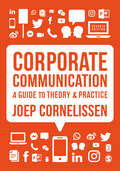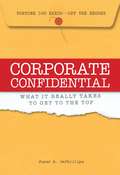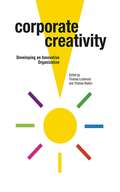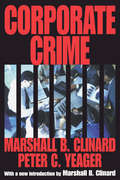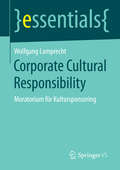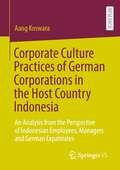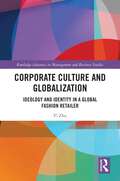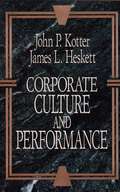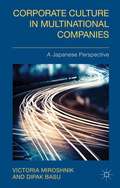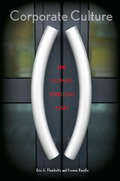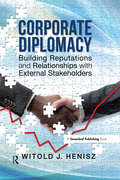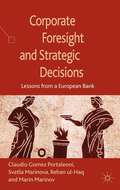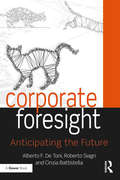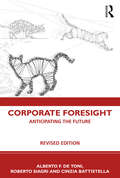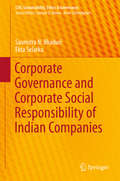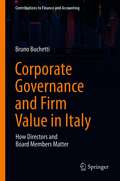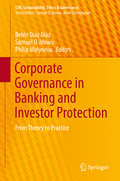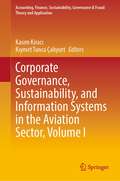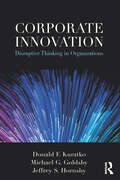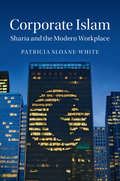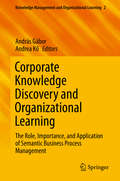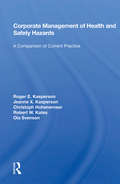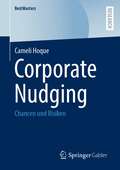- Table View
- List View
Corporate Communication: A Guide to Theory and Practice
by Joep P. CornelissenThis popular, market-leading textbook for corporate communication continues to be the authoritative and definitive textbook for students and educators. The text has been fully updated to include: • changes to the workplace in light of the Covid-19 pandemic and its impacts on employee communication via platforms such as Zoom and Microsoft Teams • the ongoing impacts of digital disruption and transformation on corporate communication at the advent of the ‘metaverse’ and alongside consideration of popular newer social media such as TikTok • the increasing focus on sustainability and the United Nations’ Sustainable Development Goals (SDGs); societal impact, purpose and corporate social responsibility; and the importance of social justice and inclusion within organizations and how these relate to organizational communication New case studies include Black Lives Matter (Starbucks); surveillance capitalism (Facebook); diversity and inclusion (Microsoft); and hybrid working (British Airways). This textbook is essential reading for communication courses including: corporate communication; organizational communication; management communication; strategic communication; and public relations. Joep Cornelissen is Professor of Corporate Communication and Management at Rotterdam School of Management, Erasmus University.
Corporate Confidential
by Susan A. DephillipsObtaining advancement in corporate America is not always nice, fair, or easy. In today's climate of economic uncertainty, you need every ounce of leverage to improve your career standing and potential. The harsh reality: If you're not constantly moving forward, you're losing professional ground-and more aggressive colleagues won't hesitate to poach your position, projects, and opportunities.
Corporate Confidential
by Susan A. DephillipsCorporate Confidential is an honest look at the unspoken truths surrounding success and failure in corporate America. Fifty senior-level executives disclose the candid realities of reaching the executive suite, including how: Refusing to play politics is professional suicide; Pursuing work/life balance will label you as a "B" player; Women unknowingly continue to sabotage their success; and more. So controversial that some executives would only participate on the promise of anonymity, Corporate Confidential provides simple, candid answers on what it really takes to achieve success in today's corporate world.
Corporate Confidential: Fortune 500 Executives Off the Record - What It Really Takes to Get to the Top
by Susan A DephillipsA Simon & Schuster eBook. Simon & Schuster has a great book for every reader.
Corporate Creativity: Developing an Innovative Organization
by Thomas Lockwood Thomas WaltonCorporate Creativity is the ultimate guide for executives and managers looking to increase creativity and innovation in their companies. This anthology of provocative essays, drawn from the pages of Design Management Review and Design Management Journal, explores personal, team, and organizational creativity, and it is packed with insights from the most respected names in the industry: Jeffrey Mauzy, Robert Rassmussen, Leonard Glick, Gerald Nadler, Stefano Marzano, and many others. These experts reveal how leading companies foster a creative culture and maximize talent resources. Essays explore managing creative staff, improving creative abilities of employees, taking risks, designing teams, integrating design and corporate philosophy into the management process, branding, and much more. Corporate Creativity is a must-have for anyone working to maximize creative potential in the workplace.
Corporate Crime
by Peter YeagerCorporate Crime, originally published in 1980, is the first and still the only comprehensive study of corporate law violations by our largest corporations. The book laid the groundwork for analyses of important aspects of corporate behavior. It defined corporate crime and found ways of locating corporate violations from various sources. It even drew up measures of the seriousness of crimes. Much of this book still applies today to the corporate world and its illegal behavior.A new introduction, "Corporate Crime: Yesterday and Today--A Comparison," prepared for this edition by coauthor Marshall B. Clinard, discusses the development of a criminological interest in corporate crime, explains the nature of corporate crime, and analyzes a number of issues involved in its study. Among the issues tackled are whether today's corporate crime is greater, more serious, and more complex; accounting fraud and its crucial role in hiding corporate crime; the pharmaceuticals, the industry with the most corporate violations; explanations of corporate crime in terms of economic factors, corporate culture, and the role of top executives; and new laws to control corporate crime and alternative approaches.
Corporate Cultural Responsibility: Moratorium für Kultursponsoring (essentials)
by Wolfgang LamprechtDie globalen Krisen seit dem Jahr 2008 haben eines sehr deutlich werden lassen: Das Vertrauen der Menschen in Wirtschaft und Politik ist signifikant gesunken. Die Wiedererlangung von Vertrauen gilt daher als oberste Prämisse für ein sozial ausgeglichenes Gesellschaftssystem und für nachhaltige Stabilität. Damit steht Unternehmenskommunikation vor einer strategischen Herausforderung: Reputation und Image müssen möglichst mit nachweisbaren Return wiederhergestellt werden. Zwar gilt die Übernahme gesellschaftlicher Verantwortung - Glaubwürdigkeit vorausgesetzt - als konstituierender Faktor für Vertrauen und Erfolgskontrolle, Kultur scheint dabei aber eine untergeordnete Rolle zu spielen. Corporate Citizenship ist das diskutierte Modell der Stunde und Corporate Social Responsibility ein wiederentdecktes Konzept: Innerhalb dessen muss sich nun eine Corporate Cultural Responsibility (CCR) als dramaturgischer Handlungsstrang zum Nutzen des Unternehmens beweisen. Wolfgang Lamprecht bietet eine Einführung in das Thema CCR.
Corporate Culture Practices of German Corporations in the Host Country Indonesia: An Analysis from the Perspective of Indonesian Employees, Managers and German Expatriates
by Aang KoswaraThis study addresses the corporate cultural practices of German companies in the host country Indonesia from the perspective of Indonesian employees, managers and German expatriates. The focus is on the intercultural challenges that arise in the practice of daily cooperation between Indonesian and German organizational members. Using qualitative methods, the study examines how these challenges are viewed and managed by organizational members, what cultural differences are evident in them and how these differences can be explained, and finally, what strategies can be used to overcome the challenges in everyday business. This ethnographic study is based on interviews with Indonesian and German organizational members, analysis of internal company journals and newsletters, and observations collected by the author as a "professional stranger" at Indonesian sites of German multinational companies. The study concludes that four cultural issues are fundamental factors in the corporate culture of German companies in the host country Indonesia: first, the implementation of a culture of integrity; second, issues of leadership in a hierarchy-driven social environment; third, the daily use of language and the flow of information in a multilingual professional environment; and finally, the creation and maintenance of harmonious, family-like working relationships.
Corporate Culture and Globalization: Ideology and Identity in a Global Fashion Retailer (Routledge Advances in Management and Business Studies)
by Yi ZhuThis book offers an ethnographic analysis of how corporate culture has been transformed in the age of globalization and promotes the importance of a national ideology’s role in corporate culture studies. Based on fifteen months of participant observation as a shop-floor salesperson, this book explores the gap between management-created corporate ideology and employees’ interpretations of and responses to this ideology. The book approaches the issue by examining the formation, dissemination, and interpretation of corporate ideology at a global Japanese fashion retailer in Hong Kong. It does so by charting the history of the company’s corporate policy: from centralized attempts at corporate employee management, through the creation of store manager "missionaries" intended to disseminate their ideology, to the ultimately unexpected outcomes as corporate ideology collided with its interpretations by store employees. The interdisciplinary nature of this book will appeal to scholars and upper level students in the fields of management, marketing, anthropology, and cultural studies as well as those interested in globalization, cross-cultural management and retail management.
Corporate Culture and Performance
by John P. Kotter James L. HeskettGoing far beyond previous empirical work, John Kotter and James Heskett provide the first comprehensive critical analysis of how the "culture" of a corporation powerfully influences its economic performance, for better or for worse. Through painstaking research at such firms as Hewlett-Packard, Xerox, ICI, Nissan, and First Chicago, as well as a quantitative study of the relationship between culture and performance in more than 200 companies, the authors describe how shared values and unwritten rules can profoundly enhance economic success or, conversely, lead to failure to adapt to changing markets and environments.With penetrating insight, Kotter and Heskett trace the roots of both healthy and unhealthy cultures, demonstrating how easily the latter emerge, especially in firms which have experienced much past success. Challenging the widely held belief that "strong" corporate cultures create excellent business performance, Kotter and Heskett show that while many shared values and institutionalized practices can promote good performances in some instances, those cultures can also be characterized by arrogance, inward focus, and bureaucracy -- features that undermine an organization's ability to adapt to change. They also show that even "contextually or strategically appropriate" cultures -- ones that fit a firm's strategy and business context -- will not promote excellent performance over long periods of time unless they facilitate the adoption of strategies and practices that continuously respond to changing markets and new competitive environments.Fundamental to the process of reversing unhealthy cultures and making them more adaptive, the authors assert, is effective leadership. At the heart of this groundbreaking book, Kotter and Heskett describe how executives in ten corporations established new visions, aligned and motivated their managers to provide leadership to serve their customers, employees, and stockholders, and thus created more externally focused and responsive cultures.
Corporate Culture in Multinational Companies
by Victoria W. Miroshnik Dipak BasuThe objective of corporate culture in a company is to align the organization's espoused values to the perceived (ideal) values of the corporation and its employees whether within the country or within the worldwide network of subsidiaries to create competitive success. We can call this value alignment among employees (irrespective of their nationality) the creation of company citizenship. We propose that company citizenship can be enhanced when the employees' personal values are in alignment with the values of the corporate culture in a multinational company. Corporate Culture in Multinational Companies examines this issue in the context of a number of Japanese multinational companies from various industrial sectors. This work explores the value component of corporate culture in these companies and their relationship with production efficiency and personal values of the employee, which create motivation. The authors combine both qualitative analysis of the experiences of leaders in these organizations and the most advanced quantitative analysis regarding corporate performance as reflected in the human resources in these organizations.
Corporate Culture: The Ultimate Strategic Asset
by Eric G. Flamholtz Yvonne RandleOrganizational culture is a quiet, but driving, influence on our perception of a company, whether as a consumer or as an employee. For instance, we know Southwest Airlines as laid back and friendly. We think of Google as innovative. To almost every well-known company we can assign a character. It is now well recognized that corporate culture has a significant impact on organizational health and performance. Yet, the concept of corporate culture and culture management is too often tantalizingly elusive. In this book, Flamholtz and Randle define culture, identifying and explaining the five key dimensions that determine it: a customer orientation; a people orientation; a process orientation; strong standards of performance and accountability; innovation and openness to change. They explain why culture is a critical factor in organizational success and failure-a key determinant of financial performance. Then, they provide a theoretically sound, highly practical, and field-tested method for managing corporate culture-presenting a set of international and domestic cases that show how actual companies have leveraged culture as the ultimate source of sustainable competitive advantage. In addition to well-known companies such as Starbucks, Ritz-Carlton, American Express, IBM, and Toyota, the text presents lesser known culture stars, such as Smartmatic and Infogix. While other titles on culture have focused too heavily on the organization as a psychological being, or on academic studies of culture as a business lever,Corporate Culturedraws on empirics to present a go-to, must-read guide for leveraging corporate culture as a source of competitive advantage and as a means of impacting the bottom line.
Corporate Diplomacy: Building Reputations and Relationships with External Stakeholders
by Witold J. HeniszManagers of multinational organizations are struggling to win the strategic competition for the hearts and minds of external stakeholders. These stakeholders differ fundamentally in their worldview, their understanding of the market economy and their aspirations and fears for the future. Their collective opinions of managers and corporations will shape the competitive landscape of the global economy and have serious consequences for businesses that fail to meet their expectations. This important new book argues that the strategic management of relationships with external stakeholders – what the author calls "Corporate Diplomacy" – is not just canny PR, but creates real and lasting business value.Using a mix of colourful examples, practically relevant tools and considered perspectives, the book hones in on a fundamental challenge that managers of multinational corporations face as they strive to compete in the 21st century. As falling communication costs shrink, the distance between external stakeholders and shareholder value is increasingly created and protected through a strategic integration of the external stakeholder facing functions. These include government affairs, stakeholder relations, sustainability, enterprise risk management, community relations and corporate communications. Through such integration, the place where business, politics and society intersect need not be a source of nasty surprises or unexpected expenses. Most of the firms profiled in the book are now at the frontier of corporate diplomacy. But they didn’t start there. Many of them were motivated by past failings. They fell into conflicts with critical stakeholders – politicians, communities, NGO staffers, or activists – and they suffered. They experienced delays or disruptions to their operations, higher costs, angry customers, or thwarted attempts at expansion. Eventually, the managers of these companies developed smarter strategies for stakeholder engagement. They became corporate diplomats. The book draws on their experiences to take the reader to the forefront of stakeholder engagement and to highlight the six elements of corprate diplomacy.
Corporate Foresight and Strategic Decisions
by Svetla Marinova Marin Marinov Claudio Gomez Portaleoni Rehan Ul-HaqThis study investigates the relationships between corporate foresight and management decision-making processes in organizations. It provides an extensive analysis of extant theories of corporate foresight and strategic management, brings in new insights, and presents an in-depth case study exploration of corporate foresight of a European bank.
Corporate Foresight: Anticipating the Future
by Alberto F. De Toni Roberto Siagri Cinzia BattistellaThis book illustrates how to anticipate the future using more than the traditional predictive models (forecasting) based on the forward projection of past experiences, and moving into more advanced methods of anticipation logic (foresight) to build probable scenarios based on weak signals, emerging trends, coexisting presents and potential paths of evolution. Utilizing a helpful, four-part structure, the authors indicate how corporate foresight is fundamental to interpret and lead change, focusing on the two cornerstones of organization and management. They advocate the separation of Research (oriented to the market of tomorrow) from Development (oriented to the market of today), the establishment of a Foresight unit and the concentration of research activities mainly on the acquisition and recombination of external know-how. After an overview of state-of-the-art literature on forecasting methods, they further propose the implementation of a "future coverage" methodology, which will enable companies to measure and verify the consistency between trends, strategic vision and offered products. These organizational and managing tools are then tested in a case study: the Italian company Eurotech SpA, a leader in the ICT sector. A useful resource for both managers and researchers, the book will help readers gain the tools necessary to tackle change and navigate complexity in organizations.
Corporate Foresight: Anticipating the Future
by Alberto F. De Toni Roberto Siagri Cinzia BattistellaThe world changes like the patterns in a kaleidoscope: trends expand, contract, break up, melt, disintegrate and disappear, while others are formed. Change – as opposed to stasis - is our normal condition, the only certainty in our lives. Hence the need to create tools that provide organizations with the means to tackle change and navigate complexity. We must accept the reality of constant change and be prepared to a heavy shift in perspective: interconnection versus separation, acceleration versus linearity, discontinuity versus continuity. Anticipating the future requires more than the traditional predictive models (forecasting) based on the forward projection of past experiences. Advanced methods use anticipation logic (foresight) and build probable scenarios taking into account weak signals, emerging trends, coexisting presents and potential paths of evolution. Corporate foresight is fundamental to interpret and lead change. The two cornerstones of foresight are organization and management. As concerns organization, the authors advocate the separation of Research (oriented to the market of tomorrow) from Development (oriented to the market of today), the establishment of a Foresight unit and the concentration of research activities mainly on the acquisition and recombination of external know-how. As regards management, after an overview of state-of-the-art literature on forecasting methods, the authors propose the implementation of a "future coverage" methodology, which enables companies to measure and verify the consistency between trends, strategic vision and offered products. These organizational and managing tools are then tested in a case study: the Italian company Eurotech SpA, a leader in the ICT sector.
Corporate Governance and Corporate Social Responsibility of Indian Companies (CSR, Sustainability, Ethics & Governance)
by Saumitra N. Bhaduri Ekta SelarkaThe book explores the theoretical and empirical issues relating to the interaction between corporate governance and corporate social responsibility (CSR) activities undertaken by Indian companies. It presents a highly detailed view on the evolution of CSR and its nexus with corporate governance. This is particularly timely in the context of the recent Indian Companies Act 2013, which mandates corporate social responsibility and revises the best corporate-governance practices for large companies. The findings of this study are unique in drawing from a unified framework of Indian corporate governance structure and corporate engagement in CSR. The book's scope is both academic and practical; the research methodology developed and utilized is useful for researchers, while the implications and the selection of variables provide useful information for practitioners and stakeholders. Finally, although it focuses on large Indian companies, the findings can also be applied to research on other emerging economies.
Corporate Governance and Firm Value in Italy: How Directors and Board Members Matter (Contributions to Finance and Accounting)
by Bruno BuchettiThis book expands on the literature on the characteristics of management boards by especially focusing on family-listed and family-controlled companies, as they are ideal for studying board heterogeneity. It uses specific multidimensional indices and in-depth econometric analysis to introduce new variables, such as international experience, that represent a source of competitive advantage for firms in today’s globalized world. In addition, by examining the heterogeneity ratio and the representation of independent and family directors, the book demonstrates how family-controlled firms use independent directors to import their heterogeneous expertise. The book makes a threefold contribution: for regulators, it offers suggestions on improving the quality of reporting in family-controlled firms; for researchers, it demonstrates the importance of including directors’ characteristics apart from the firm-specific factors in their analyses; and for practitioners, it shows that selecting directors with specific characteristics can have a substantial impact on firms’ performance.
Corporate Governance in Banking and Investor Protection: From Theory to Practice (CSR, Sustainability, Ethics & Governance)
by Samuel O. Idowu Philip Molyneux Belén Díaz DíazThis book explores the status quo of corporate governance in banking and investor protection from both theoretical and practical perspectives. Bringing together original conclusions with a regional and international focus, it provides a timely and comprehensive overview of the effectiveness of corporate governance in the financial sector and an assessment of investor protection. It also includes a number of examples and case studies to illustrate the findings. The book compares corporate governance in the banking and financial industries before and after the financial crisis, and helps to evaluate the effect of the recommendations and regulations that have been developed in the interim.
Corporate Governance, Sustainability, and Information Systems in the Aviation Sector, Volume I (Accounting, Finance, Sustainability, Governance & Fraud: Theory and Application)
by Kıymet Tunca Çalıyurt Kasım KiracıThis book delves into corporate governance, sustainability, and information systems related to the aviation sector. Due to globalization and rise in cross-border business, the aviation sector has become an essential means of transport. However, the industry has tremendous impact on social, economic, and natural environments and carries significant risks. The book explores such issues plaguing the aviation sector under three key areas: CSR and sustainability, information systems and risk management, and corporate governance and accountability in the airline industry. The book concludes with an analysis of the impact of COVID-19 crisis on the industry and ways to respond and recover from the effects of the pandemic.
Corporate Innovation: Disruptive Thinking in Organizations
by Donald F. Kuratko Jeffrey S. Hornsby Michael G. GoldsbyEffectiveness is the underlying theme for this introduction to disruptive innovation. The book tells the manager, or student, what they need to know in transforming the thinking in an organization to an innovative mindset in the twenty-first century.Corporate Innovation explains the four stages of the innovation process, and demonstrates how to improve skills in the innovation process, and unleash personal innovative abilities. This book also presents ways to assess the organization’s attitudes toward innovation, providing insights into how to diagnose creative and innovative performance problems in the organization. Beginning with an overview of concepts involved with an innovative organization today, this book explores the fundamental aspects of the individual, the organization and the implementation. An I-Organization is a combination of: I-Skills developed within individuals I-Design thinking functions needed to shape innovation I-Teams that emerge from the HR perspective of structuring the appropriate climate I-Solution needed to provide a foundation for implementing any innovative ideas Essential reading for students of corporate innovation, corporate ventures, corporate strategy, or human resources, this book also speaks to the specific needs of active managers charged with the expectation of enhancing the innovative prowess of their organization.Instructors’ outlines, lecture slides, and a test bank round out the ancillary online resources for this title.
Corporate Islam
by Patricia Sloane-WhiteCompelling and original, this book offers a unique insight into the modern Islamic corporation, revealing how power, relationships, individual identities, gender roles, and practices - and often massive financial resources - are mobilized on behalf of Islam. Focusing on Muslims in Malaysia, Patricia Sloane-White argues that sharia principles in the region's Islamic economy produce a version of Islam that is increasingly conservative, financially and fiscally powerful, and committed to social control over Muslim and non-Muslim public and private lives. Packed with fascinating details, the book is essential reading for anyone with an interest in Islamic politics and culture in modern life.
Corporate Knowledge Discovery and Organizational Learning: The Role, Importance, and Application of Semantic Business Process Management (Knowledge Management and Organizational Learning #2)
by András Gábor Andrea KőThis book investigates organizational learning from a variety ofinformation processing perspectives. Continuous change and complexity inregulatory, social and economic environments are increasingly forcingorganizations and their employees to acquire the necessary job-specificknowledge at the right time and in the right format. Though many regulatorydocuments are now available in digital form, their complexity and diversitymake identifying the relevant elements for a particular context a challenging task. In such scenarios, business processes tend to be important sources ofknowledge, containing rich but in many cases embedded, hidden knowledge. This book discusses the possible connection between businessprocess models and corporate knowledge assets; knowledge extraction approachesbased on organizational processes; developing and maintaining corporateknowledge bases; and semantic business process management and its relation toorganizational learning approaches. The individual chapters reveal the differentelements of a knowledge management solution designed to extract, organize andpreserve the knowledge embedded in business processes so as to: enrichorganizational knowledge bases in a systematic and controlled way, supportemployees in acquiring job role-specific knowledge, promote organizationallearning, and steer human capital investment. All of these topics are analyzedon the basis of real-world cases from the domains of insurance, food safety,innovation, and funding.
Corporate Management Of Health And Safety Hazards: A Comparison Of Current Practice
by Roger E. KaspersonThis book provides one of the first systematic accounts of how corporations manage risk to workers and consumers. Careful analysis and interviewing in different corporations elicit a portrait of the myriad hazards that currently confront industry, the corporate programs and resources that have emerged since 1970 to respond to this challenge, and factors that have contributed to successes and failures. In-depth studies of the Volvo Car Corporation, Rocky Flats nuclear weapons plant, Union Carbide's Bhopal facility, and large chemical and pharmaceutical corporations provide a state-of-the-art assessment of the advances and problems inherent today in industrial safety management. Roger E. Kasperson, Jeanne X. Kasperson, and Christoph Hohenemser are senior researchers at Clark University's Center for Technology, Environment, and Development (CENTED). Roger E. Kasperson is Director of CENTED and its Hazard Assessment Group. Jeanne X. Kasperson is Research Librarian at CENTED and Senior Research Associate in Brown University's World Hunger Program. Hohenemser, a professor of physics, directs the Environment, Technology, and Society Program at Clark University. Robert W. Kates, formerly with CENTED, is Director of the Alan Shawn Feinstein World Hunger Program at Brown University. Ola Svenson, of the Department of Psychology at Lund University in Sweden, is a leading researcher in the field of risk perception and decision analysis.
Corporate Nudging: Chancen und Risiken (BestMasters)
by Cameli HoqueDieses Buch widmet sich der Frage, wie private Unternehmen die Erkenntnisse der Verhaltensökonomie nutzen und Nudges erfolgreich in der Praxis einsetzen können. Die Untersuchung zeigt, dass Nudges sowohl im Mitarbeitermanagement als auch bei der Beeinflussung des Verbraucherverhaltens eine große Palette an vielversprechenden Anwendungsmöglichkeiten bieten. Die Arbeit betont jedoch auch potenzielle ethische Risiken und unerwünschte Auswirkungen und liefert umfangreiche Erkenntnisse über effektive Nudge-Techniken, ethische Überlegungen und Handlungsempfehlungen für Unternehmen.
